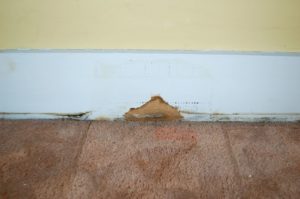Mold in RV/Trailer/Camper/Mobile Home Walls and Ceiling
Just like in a building, mold can easily get into RVs, trailers, campers, and mobile homes if the conditions are right. Below, you can find details on mold and the processes of remediating it.

Health Issues
Mold causes various health issues, the severity of which depends on a number of factors like what type of mold is present, how much mold is present, and how many mold toxins are in the air. In general, black mold is one of the most hazardous types due to it’s relatively high level of mycotoxins. White mold, on the other hand, is often a little bit less toxic partially because it doesn’t release quite as many mycotoxins. Here are some symptoms to look out for that are commonly caused by mold:
- Coughing
- Sneezing
- Watery Eyes
- Itchy eyes
- Runny nose
- Trouble sleeping
- Brain fog
Do I Need to Get a Mold Test Done?
In most cases, a mold test is not necessary, although it could be helpful in certain circumstances such as:
- There has been some kind of recent water damage
- When the mold is not visible, but there is a smell
- To make sure that mold has been properly abated after the mold remediation process has been completed
- Health concerns
- If you are buying or selling a property
- Disputes with a landlord or tenant
- To test your overall indoor air quality
If you would like to have one done, you should hire a professional or use the kit on this page.
How Can Mold Get into an RV?
In order to grow, mold only requires a moisture source and a food source, both of which can be commonly found in campers. Other factors that contribute to mold growth are temperatures of around 70 degrees Fahrenheit and poor ventilation. If you have had a recent incident with water damage in your RV, we recommend hiring a professional to help clean it up for you in order to avoid mold.
Can There Be Mold Present Even If It Is Not Visible?
Yes, there are many situations in which mold can be damaging to your health and property without you seeing it. If you suspect that you may have mold due to the smell or for any other reason, as mention above, we suggest that you call a mold detection specialist right away or check out the testing kit on our recommended products page.
What Can You Do to Prevent Mold from Growing?
Other than being careful to avoid moisture issues, you can do a few other things to lower your chances of having mold grow in your RV. Here is a list:
- Use vent fans and dehumidifiers
- Keep your RV ventilated
- Waterproof areas of the RV
- Fix any leaks
What Should You Do About Mold Spores?
Mold spreads in your property via mold spores, which can also cause health issues. To help remove them, we suggest using a HEPA vacuum or air purifier and negative air pressure.
Negative Air Pressure
By running an exhaust fan out of a window or open door, negative air pressure can help you get rid of mold and its spores. This is particularly helpful during the mold remediation process as it prevents spores from spreading to other parts of the property.
Cleaning Mold Contaminated Personal Items
Some mold contaminated materials are easier to save than others. In general, non-porous materials like glass, metals, or hard plastics can be cleaned and reused, while porous materials like drywall or carpet need to be disposed of. It is important to gauge how valuable certain items are to you, since the cost of cleaning them can be more than they are worth.
Containing an Area
An important part of the mitigation process is making sure that the mold damaged area is properly contained, thus lowering the chances of the mold spreading or growing back. Typically, contractors will use polyethylene sheeting to contain an area.
Protective Gear for Mold Abatement
Mold specialists typically wear protective gear to keep themselves safe from mold spores and other toxins that may be present during the restoration process. Some of this protective gear includes:
- Dust masks or respirators
- Protective eyewear
- Gloves
- Sanitizable or disposable suits that cover your entire body
Disposing of the Mold Damaged Materials
Properly disposing of mold damaged materials can help lessen your chances of having mold grow back. To do this, professionals should double bag the materials in polyethylene sheeting and clean the outside of the bags. Additionally, it is a good idea to not carry the bags containing the contaminated materials through the mobile home, and instead dispose of them through a viable door or window.
Moisture Detection
As mentioned before, moisture is a major factor that mold needs in order to grow in any property. That is why the detection and repair of a moisture source is an important part of the mold abatement process. You or your restoration contractor can use a moisture meter like this one to check for moisture in your camper.
Water Damage Repair
Once the moisture has been detected and repaired, your contractor can use fans and dehumidifiers to dry the trailer or RV. If needed, they should also document this process and provide information to your insurance company.
Call Today for a Free Estimate
If you suspect that you are having mold issues in your mobile home, give us a call today for a free quote on remediation!